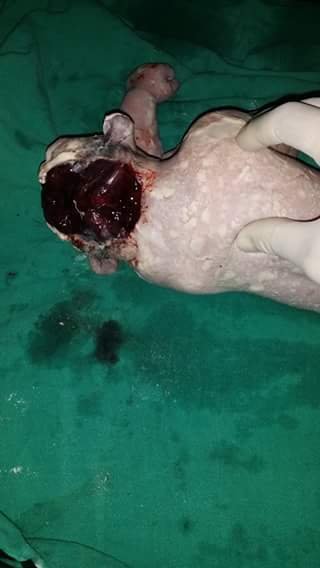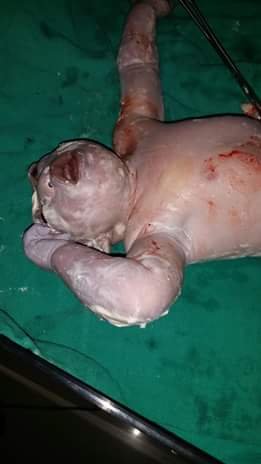ANENCEPHALY :- "a grief, a parent can never mitigate with"
Hope you all are doing well.
It has been a long time I wrote any post.I am really sorry for the inconvenience.I had my exams and I was really busy with my syllabus to be completed, so I was vanished for a while.But from now I will be continuing with my posts and blogs.
Today I will be dealing with one of the less common but a significantly griveous birth defect which I encounter in my Hospital where I am pursuing my medical education.Till now I have approached only one case, but it was sufficiently overwhelming.Hope I will not be seeing anymore in my life time again.It's so painful and awful to see it again and again.
So continuing with the post...

image source Ed Uthman, MD
(Anencephalic infant)
What is Anencephaly?
Anencephaly is a birth defect in which the major parts of the brain, scalp, and skull of the fetus do not form completely in the womb.It is a cephalic disorder that results from a neural tube defect.Neural tube is an embryonic hollow structure from which the brain and spinal cord developes.When the head end of the neural tube fails to close mainly at the level of base of skull usually 23rd and 26th day following conception, anencephaly results.
Anencephaly results in only minimal development of the brain. Often, the brain lacks telencephalon, the largest part of the brain consisting mainly of the part or all of the cerebral hemisphere (the area of the brain that is responsible for thinking, vision, hearing, touch, and movement), including the neocortex which is responsible for cognition such as sensory perception, generation of motor commands, spatial reasoning, conscious thoughts etc. There is no skin, bony covering, meninges over the back of the head and there may also be missing bones and the other structures around the front and sides of the head.With very few exceptions, infants with this disorder do not survive longer than a few hours or possibly days after their birth.

(Anencephaly showing abscence of cranial vault.
This picture was taken by me on 23rd march 2018 in
Nobel medical college and teaching Hospital Biratnagar, Morang Nepal)

(Same anencephalic infant in ventral position.
This picture was taken by me on 23rd march 2018 in
Nobel medical college and teaching Hospital Biratnagar, Morang Nepal)
What is its causes?
As I have already discussed that Anencephaly results due to incomplete closure of rostral(head) end of the Neural tube.So before discussing the pathophysiology of Anencephaly, let us look through the development of neural tube.
Neural tube and its development
Neural tube is a hollow structure formed by the closure of ectodermal tissue in the early vertebrate embryo that later develops into the brain, spinal cord, nerves, and ganglia.
Initially the Central nervous system(Brain and Spinal cord) begins as a simple neural plate which fold to form a groove and then tube and open initially at each end.

image sourceby Abitua
(In the above picture we can see the sequential growth of neural tube from neural plate.The either ends of this neural tube represent the future mouth and anus i.e. the cephalic and the caudal end of developing embroy)
The Neural tube develop in two ways:- primary and secondary neurulation.
1.In Primary neurulation, ectoderm divide into three cells
- The internally located neural tube
- The externally located epidermis
- The neural crest cells, develop in the region between the neural tube and epidermis but then migrate to new locations
2.In secondary neurulation, the cells of the neural plate form a cord-like structure that migrates inside the embryo and hollows to form the tube.

image sourceby ArneLH CCo3
(In the above picture we can see that in primary neurulation, the neural plate creases inward until the edges come in contact and fuse whereas in secondary neurulation, the tube forms by hollowing out of the interior of a solid precursor)
So from the above pictures we can imagine the major site of development of Anencephaly.
Well, the exact causes of anencephaly among most infants are unknown. Some babies have Anencephaly because of a change in their genes or chromosomes. Anencephaly might also be caused by a combination of genes inherited from both parents coupled with environmental and other factors, such as the things the mother comes in contact within the environment or what the mother eats or drinks, or certain medicines she uses during pregnancy.
Folic acid has been shown to be important in neural tube formation and as a subtype of neural tube defect, folic acid may play a role in Anencephaly. Studies have shown that the addition of folic acid to the diet of women of child-bearing age may significantly reduce, although not eliminate, the incidence of Anencephaly.
Hence Anencephaly has multifactorial traits, meaning many factors, both genetic and environmental, contribute to its occurrence.
Epidemiology
About 1 in nearly 5,000 babies is born with anencephaly each year world wide, as per the Centers for Disease Control. The exact number is not known because many pregnancies involving neural tube defects end in miscarriage. More female newborns have anencephaly than males, possibly because of a higher rate of spontaneous abortions or stillbirths among male fetuses.
Centers for Disease Control and Prevention estimates that each year, about 3 pregnancies in every 10,000 in the United States will have anencephaly.This means about 1,206 pregnancies,from 325.7 million US population(2017 census report) are affected by this condition each year in the United States. Rates may be higher among Africans with rates in Nigeria estimated at 3 per 10,000 in 1990 while rates in Ghana estimated at 8 per 10,000 in 1992. Rates in China are estimated at 5 per 10,000.
In about 90 percent of cases, the parents of an anencephalic infant do not have a family history of the disorder. However, if the parents have had a child who was born with anencephaly, they have 3% risk of having another baby with this condition as opposed to the background rate of 0.1% occurrence in the large group of population.The recurrence rate for anencephaly is 4 to 5 percent, and rises to 10 to 13 percent if the parents have had two other children with anencephaly. It is important to understand that the type of neural tube defect can differ the second time. For example, one child could be born with anencephaly, while the second child could have spina bifida.
How it is diagnosed?
Ultrasonography is one of the cheap and reliable modality to diagnose anencephaly during pregnancy.It is often diagnosed after birth of the baby by general physical examinations.Following features in the newly born baby help in diagnosing the case of Anencephaly. These are
- The baby's head often appears flattened due to the abnormal brain development and missing bones of the skull.
- Absence of bony covering over the back of the head
- Missing bones around the front and sides of the head
- Folding of the ears
- Cleft palate:- A condition in which the roof of the child's mouth does not completely close, leaving an opening that can extend into the nasal cavity.
- Congenital heart defects
- Some basic reflexes, but without the cerebrum, there can be no consciousness and the baby cannot survive
Beside this, the prenatal modalities for diagnosing Anencephaly are
- Alpha-fetoprotein:- A protein produced by the fetus that is excreted into the amniotic fluid. Abnormal levels of alpha-fetoprotein may indicate brain or spinal cord defects, multiple fetuses, a miscalculated due date, or chromosomal disorders.
- Amniocentesis:- A test performed to determine chromosomal and genetic disorders and certain birth defects. The test involves inserting a needle through the abdominal and uterine wall into the amniotic sac to retrieve a sample of amniotic fluid.
- Ultrasound:-A diagnostic imaging technique that uses high-frequency sound waves and a computer to create images of blood vessels, tissues, and organs. Ultrasounds are used to view internal organs as they function, and to assess blood flow through various vessels.
- Blood tests for Alpha-fetoprotein, a protein produced by the immature liver cells of the fetus.
- Fetal MRI: This imaging test uses a magnet to generate an image of the developing fetus. The brain and its various structures can be seen in more detail than the ultrasound alone.
Any of these procedures may be performed between the 14th and 18th weeks of pregnancy. The fetal MRI can be performed at any point of the pregnancy.
Is it treatable?
There is no known cure or standard treatment for anencephaly. Almost all babies born with anencephaly will die shortly after birth.Treatement is just supportive. The infant should be kept warm and any areas of the brain that are exposed must be protected. Sometimes a special bottle is used to help feed babies who may have difficulty swallowing fluids.
Experiencing the loss of a child can be very traumatic. Grief counseling services are available to help and cope with the loss of a child.
How can Anencephaly be prevented?
Methods for preventing anencephaly includes the following:-
- Proper nutrition:- Eating nutritious foods and taking vitamin supplements before and during pregnancy may help prevent neural tube defects. Getting enough folic acid is very important. Women of childbearing ages should take a daily multivitamin supplements with at least 400 micrograms of folic acid, since most women do not obtain enough folic acid from food alone. The synthetic form of the vitamin is more easily absorbed and utilized by the body than the form which occurs naturally in foods.
Other good sources of folic acid include leafy green vegetables, dried beans, oranges, and orange juice. Some products are fortified with folic acid, including enriched flour, rice, bread, pasta, and cereals. The U.S. Food and Drug Administration requires that folic acid be added to all enriched cereal grain products.Since the United States began fortifying grains with folic acid, there has been a 28% decline in pregnancies affected by neural tube defects. - Folic acid supplements:- Pregnant women who have previously given birth to an infant with a neural tube defect may have to take higher amounts of folic acid during pregnancy. Women should talk to their doctors about the recommended amount of folic acid. It is suggested that women who have had a previous pregnancy involving a neural tube defect should take 4 mg of folic acid, beginning one to two months before conception through their first trimester of pregnancy, under a doctor's supervision.
- Genetic counseling may be recommended by the doctors to discuss the risk of recurrence in a future pregnancies along with vitamin therapy.
Folic acid should be taken 4 weeks BEFORE conception.Neural tube defect occurs before most woman know they are Pregnant
References:-
1.https://www.cdc.gov/ncbddd/birthdefects/anencephaly.html
2.https://en.wikipedia.org/wiki/Anencephaly
3.http://www.stlouischildrens.org/diseases-conditions/anencephaly
4.https://my.clevelandclinic.org/health/diseases/15032-anencephaly
5.https://onlinelibrary.wiley.com/doi/full/10.1002/ajmg.c.30049
6.https://www.questdiagnostics.com/testcenter/testguide.action?dc=CF_PrenatScreen
7.https://en.wikipedia.org/wiki/Neural_tube
8.http://www.cogsci.ucsd.edu/~sereno/596/readings/03.12-NeuralTube.pdf
#Steemstem
The Steemstem team has been working for over one year and now to promote informative S-Science T-Technology E-Engineering and M-Mathematics posts on steemit.The project aims is to build a community of Science and Technology lovers on steemit and aid in fostering the growth of posts and blogs.
To learn more about the project, you can join the channel in Discord here[https://discord.gg/mKSKQ7T].
Congratulations! This post has been upvoted from the communal account, @minnowsupport, by Amit from the Minnow Support Project. It's a witness project run by aggroed, ausbitbank, teamsteem, theprophet0, someguy123, neoxian, followbtcnews, and netuoso. The goal is to help Steemit grow by supporting Minnows. Please find us at the Peace, Abundance, and Liberty Network (PALnet) Discord Channel. It's a completely public and open space to all members of the Steemit community who voluntarily choose to be there.
If you would like to delegate to the Minnow Support Project you can do so by clicking on the following links: 50SP, 100SP, 250SP, 500SP, 1000SP, 5000SP.
Be sure to leave at least 50SP undelegated on your account.